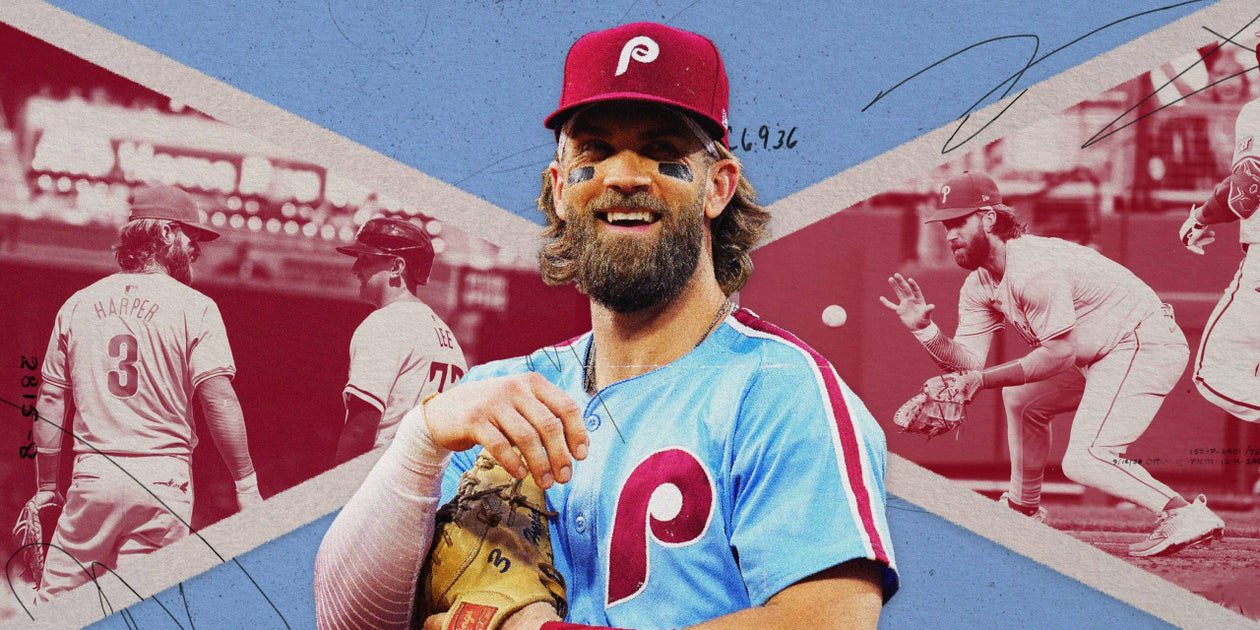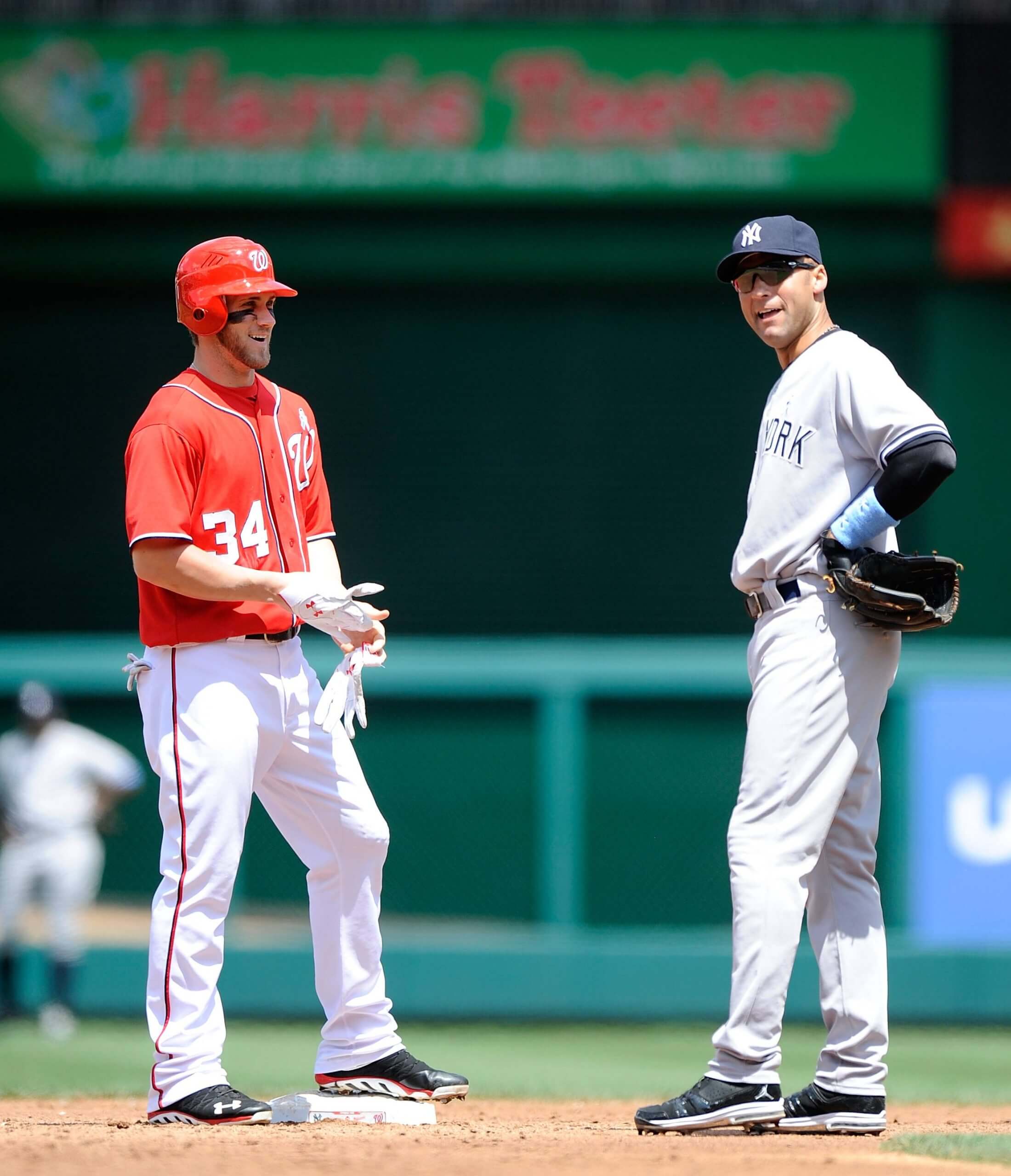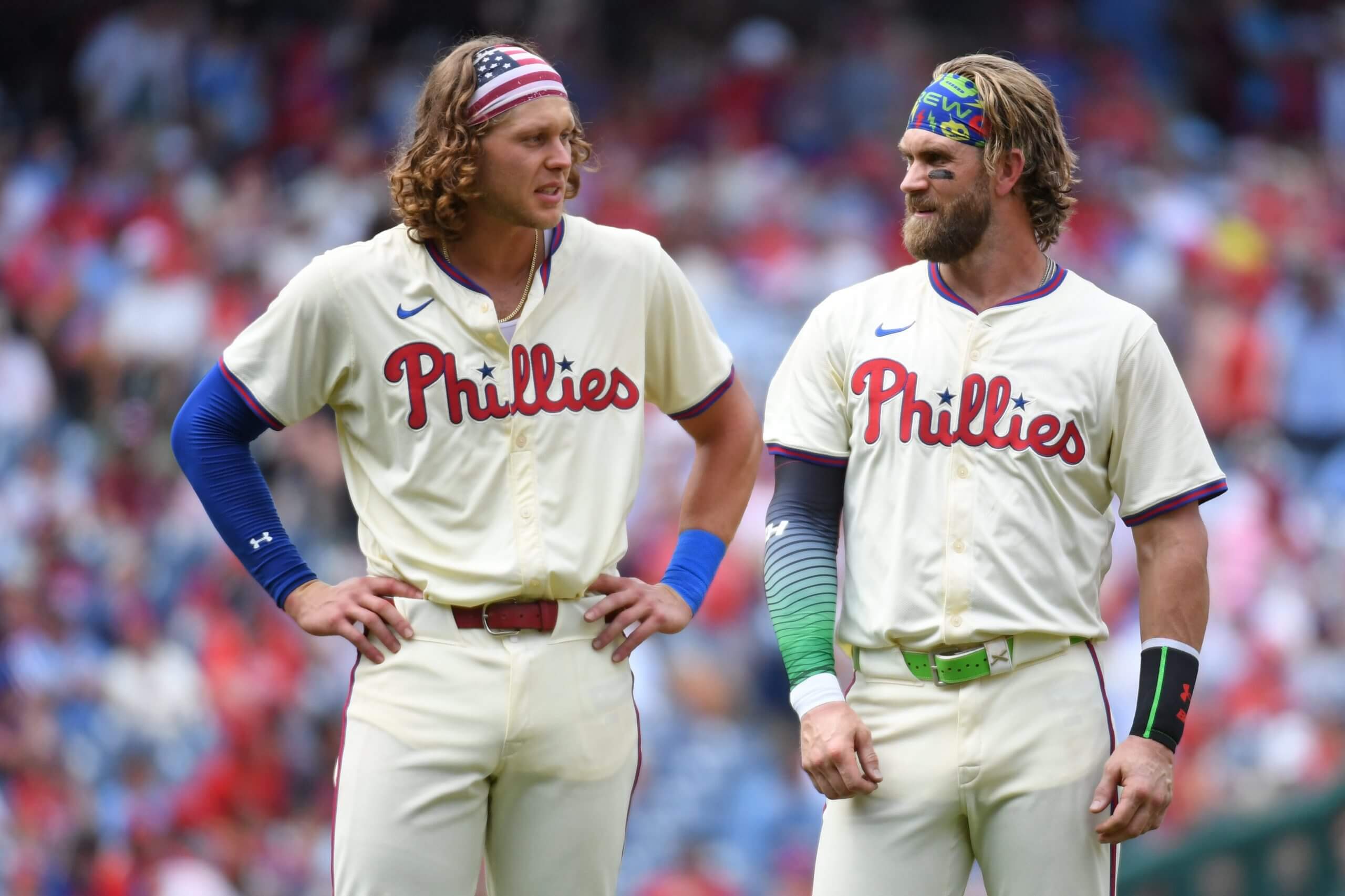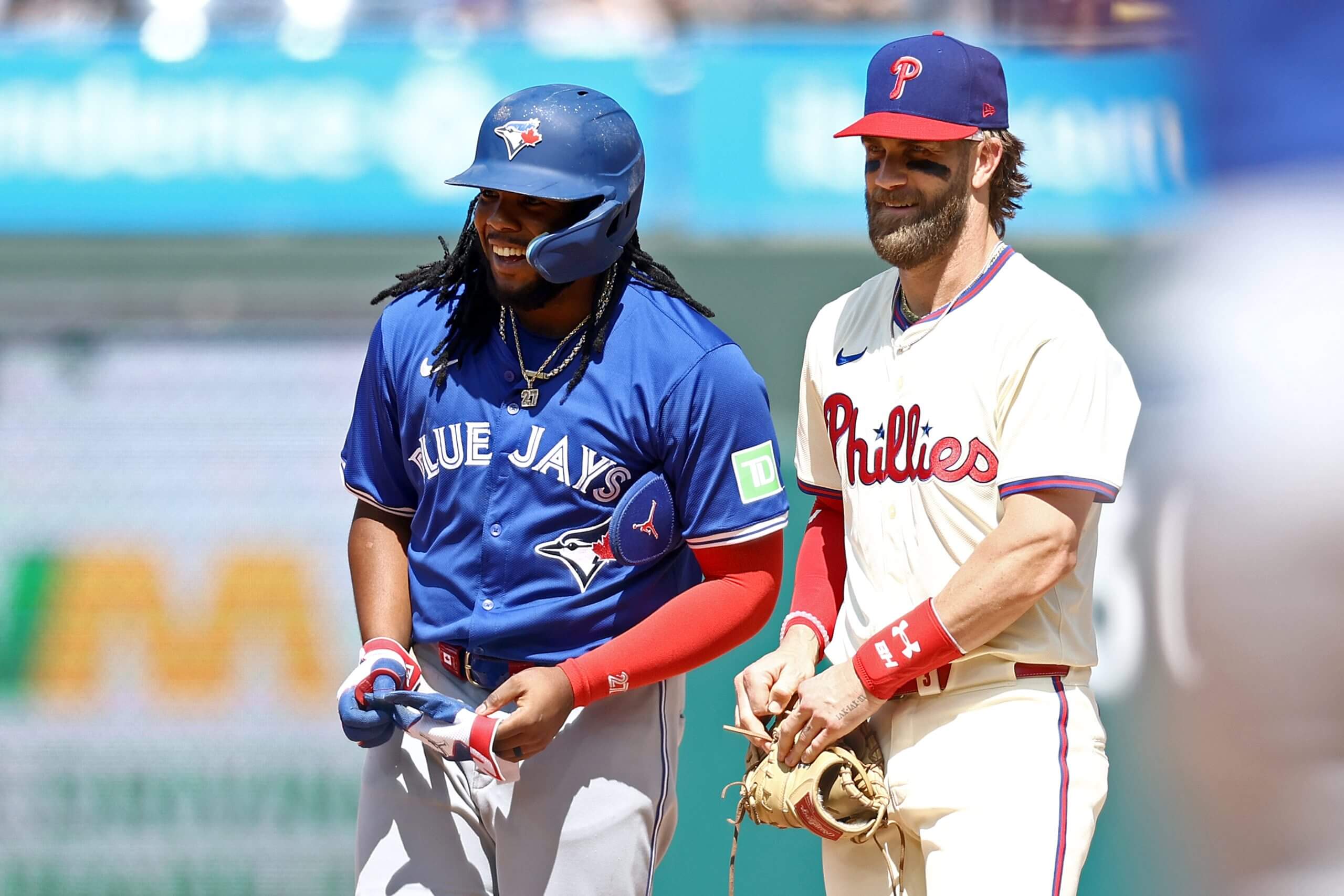
Corbin Carroll drew a five-pitch walk in the third inning of a forgettable Friday night in June. He had experienced the greatest thrill of his budding career at Citizens Bank Park last October but, as he jogged to first base, he was hitting .217. His confidence was cracking. Bryce Harper greeted Carroll. He put his right hand on Carroll’s shoulder.
“I got something for you,” Harper said.
“OK,” Carroll said, “text me, text me.”
“No,” Harper said. “It’s nothing swing-wise. Just remember what name’s on your back.”
Harper tapped Carroll’s shoulder. That was it. The Arizona Diamondbacks outfielder went 0-for-7 in the rest of the series, but in the weeks after, he emerged from his slump. Harper had not provided Carroll with a detailed fix to his swing. He had heard similar advice before.
But Harper’s words stuck with the 24-year-old outfielder.
“For him to have — obviously, we’re competitors, right?” Carroll said. “And the way last year ended for them, there was pretty much no reason for him to be that way other than doing it out of the kindness of his heart and knowing how hard this game is. That’s something I definitely hope to emulate.”
6/21/24: Bryce Harper reminds Corbin Carroll to remember the name on his back
📸: me pic.twitter.com/gWeTlWd5pF
— Grace Del Pizzo (@GraceDelPizzo) July 6, 2024
Harper’s first full season as a first baseman is almost over. He’s authored another productive year with the Philadelphia Phillies. He’ll finish in the top 10 of National League MVP voting. He might be a Gold Glove Award finalist at first base. He’s had his ups and downs. He played through nagging injuries. He has a chance to win a World Series ring next month.
But, around the sport, opponents have started to see a version of Harper that was shrouded before. He turns 32 in October. He has spent 13 seasons in the majors. The game has changed since he debuted; Harper has embraced his place in a sport that now skews younger and doesn’t punish personality.
He’s found a home at first base.
“I feel like,” Harper said, “it’s helped me love the game more.”
If a young hitter stepped into Harper’s office at first base this season, there’s a chance the superstar had something to tell him. Sometimes, it was an innocuous piece of swing advice or congratulating a player on his debut. Sometimes, it was a simple reassurance. All of it mattered because it came from Harper — often unprompted.
Word traveled fast. Earlier this month, a young player reached first and Harper nodded at him.
“Hey, man,” the player said to Harper. “Everybody around the league is telling me that I need to talk to you about my swing.”
Harper knows how this is going to sound. How could he help an opponent? This is not the same game he entered as a wide-eyed 19-year-old. His cockiness was perceived as a threat back then. He wielded a gray bat for his big-league debut on April 28, 2012, prompting a letter from Major League Baseball telling him that he could not use it again. He remembered trying to break the ice with Buster Posey, one of the greatest catchers of his era.
“What’s up, Buster?” a young Harper said to him.
Silence.
“He stoned me,” Harper said. “But then later on in his career, he’s talking to me. That’s just how the game worked.”
Same thing with Chipper Jones and Todd Helton and Troy Tulowitzki — guys Harper idolized and then shared a field with. They weren’t bad people, Harper learned; they were upholding a standard. This was the way.
Two months into Harper’s career, the Washington Nationals played the New York Yankees. Harper was on second base. Derek Jeter made eye contact. “You’re a great player,” Harper remembered Jeter telling him. “You’ll have a great career. Congratulations.” Harper could not believe it.
“Damn,” he said. “That’s Derek Jeter.”

Bryce Harper, 19, talks with Derek Jeter, 38, during his 2012 rookie season. (G Fiume / Getty Images)
A few months ago, 23-year-old Minnesota Twins infielder Brooks Lee reached first base against the Phillies. Lee was 11 when Harper debuted. He’s watched Harper’s entire career. Lee told him who he was and Harper’s eyes lit up; Lee’s father, Larry, is the longtime baseball coach at Cal Poly.
“When I was a kid,” Brooks Lee said, “my dad told me he thinks he’s the first guy to go see Bryce Harper and recruit him. I told him that.”
Harper remembered.
“That,” he said, “was one of my first letters in the mail.”
It was the second inning at Target Field. Harper had homered an inning earlier. “Hey,” Lee said to him, “nice f—ing swing.” Harper offered some tips. Nothing Lee hadn’t heard before. They went their separate ways.
Before, when Harper played right field, he admitted his mind would drift. “You start thinking about your at-bats,” Harper said. “You think about this, you think about that.” He grew up as a catcher and a third baseman. He had to be engaged while on the dirt. That’s when the game was purest to Harper.
Moving to first base has revived some of those feelings. This is why Harper started talking more to opposing players.
“It’s being able to see the human element, as well,” Harper said. “You know how intense I am on the baseball field. I’m a very intense person. But talking to them gets you away from being so intense where it’s just overbearing.”
Over time, he’s become more accessible to his younger teammates. He has frequent talks with Alec Bohm about the mental side of hitting. He wants to be regarded as one of the best ever — and someone who cares.
“Obviously, I don’t want to help them when we’re playing against them,” Harper said. “So I think it’s that give and take. But, also, I’m not scared of other players having success. I don’t want them to have success against us. I don’t. But I never want them to not be confident in their ability.
“I want every single guy when they get to the big leagues to really have success and enjoy what they do. Enjoy each moment. Find gratitude in the moment. Find gratitude in the struggle. Find gratitude in the moment of having success. Enjoy the success. Enjoy the struggle, too.”

Bryce Harper often talks hitting with younger teammates such as Alec Bohm. (Eric Hartline / USA Today / Imagn Images)
Vladimir Guerrero Jr. shuffled toward Harper after he drew a walk in an early May game at Citizens Bank Park. Guerrero had homered only four times in his first 36 games. Harper glanced at the scoreboard and saw the 25-year-old’s dull numbers.
“If you just clean this up a little bit, I think you’re going to take off,” Harper remembered telling Guerrero. “You’re going to have a great year.”
The two stars, Guerrero said, made a pinky promise not to discuss the specifics. Harper said it was a tiny thing, something Guerrero had already heard. He took no credit for Guerrero’s torrid four months since they spoke. It is, to Harper, a funny coincidence.
“It’s crazy because I struggle myself, right?” Harper said. “Like, I sit there and I’m like, ‘How can I not get myself out of it so quick?’ Because the game is hard and it’s humbling. But if I can make somebody else click — my teammate or somebody else, I find joy in that.”

Vladimir Guerrero Jr. and Bryce Harper share a laugh at first base this season. (Tim Nwachukwu / Getty Images)
Near the end of last season, when the Phillies were playing the New York Mets, Harper shared an observation with rookie infielder Mark Vientos. “Hey, you got a lot of power,” Harper told him. “You don’t need to swing as hard as you do.” It was simple. It became something Vientos thought about often.
“I mean, it means a lot,” Vientos said. “Bryce Harper is someone I looked up to watching the game. Getting advice from one of the best players is obviously meaningful.”
Colorado Rockies outfielder Brenton Doyle, who overhauled his swing before the season, grew up a Nationals fan. In April, Harper tapped him on the leg and told him he liked the new approach. “I knew once a guy like him said that to me,” Doyle told MLB Network Radio, “I’m doing something right.”
Harper was Atlanta Braves outfielder Jarred Kelenic’s favorite player as a kid. Kelenic wanted to emulate his path. A few years ago, he was afraid to introduce himself. He didn’t want to bother Harper.
Now, he’s had the chance to talk to Harper at first base. Harper tells Kelenic to stay inside the ball. Be short to it. Use the big part of the field. The hitting lingo that is passed around every cage.
Kelenic appreciates how approachable Harper has become.
“I’ve seen him talk to a bunch of guys, for sure,” Kelenic said. “First base is a good spot to be personable.”
Carroll actually credited another former Phillie, Marlon Byrd, for unlocking his swing this summer — as detailed in a recent Arizona Republic story. But he has come to see Harper’s gesture as a symbolic one. “Part of it is the game is getting younger,” Carroll said, “and younger players being more relied on to play an everyday role.” Harper was once on an island and commanded everyone’s attention as a teenager. He has never forgotten it.
“I want all of them just to enjoy this moment,” Harper said. “Just go play your game. Because you don’t have to be the big guy. There comes a time when you’re going to have to be the guy.”
Sometimes, Harper sounds wistful about those days when he wasn’t The Guy. He is 31 and more than half of his life has been conducted under a microscope. He’s a father of three now; the constant attention can be exhausting. Maybe that’s why he has connected with the sport’s youngest players.
Maybe he just likes to talk baseball.
“It was super cool,” Carroll said, “for someone in his position to act that way and be that way.”
Harper laughs about some of the interactions now that word has spread. When a rookie reached first base earlier this season, Harper congratulated him on being in the majors.
“It’s crazy you know my name,” the rookie said. “I’m going to tell my dad!”
A different young player was the one who first told Harper everyone around the league was talking about his swing advice. “What do you mean?” Harper said. It’s just this thing, the player said to him. He wanted in.
“What you got?” he asked Harper.
Harper stared him down.
“I ain’t f—king helping you,” Harper said.
The two started laughing. Harper imparted advice; he doesn’t even remember what. It was probably a cliché. But it meant something because it came from him. The feeling is mutual. At home at first base, Harper has found joy in paying it forward.
“It’s awesome,” Harper said. “It’s amazing. They’re still kids, man. They’re still kids just playing the game.”
— The Athletic’s Dan Hayes, Kaitlyn McGrath and David O’Brien contributed to this report.
(Top image: Kelsea Petersen / The Athletic. Bryce Harper, center: Mitchell Leff / Getty Images; Harper and Brooks Lee, left: Brace Hemmelgarn / Getty Images; Harper, right: Ed Zurga / Getty Images)